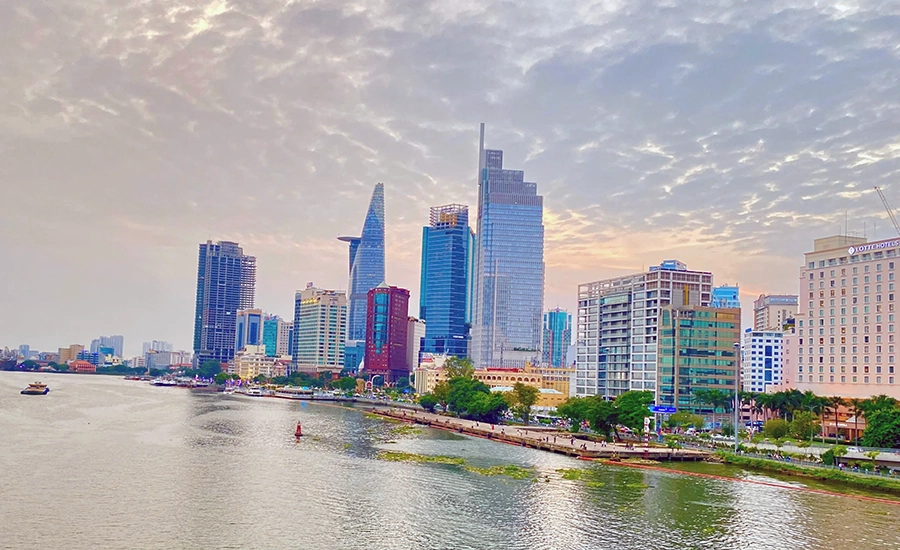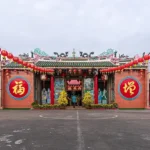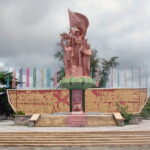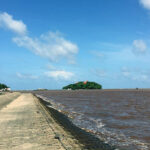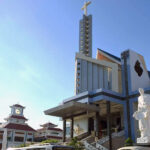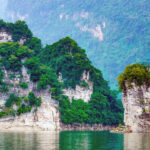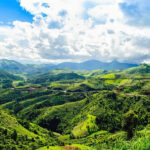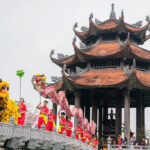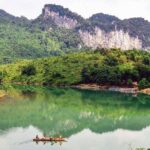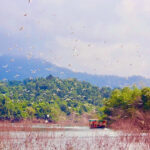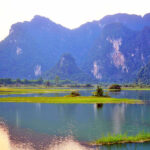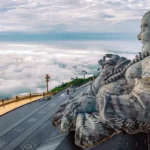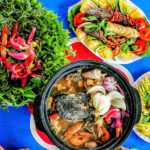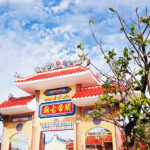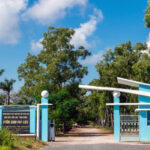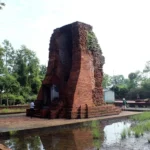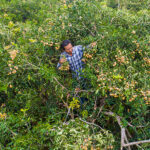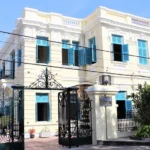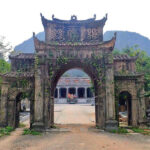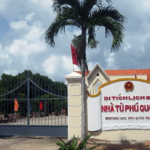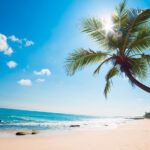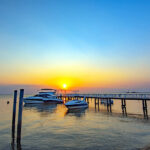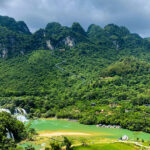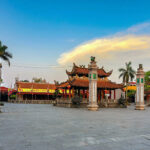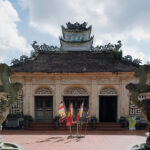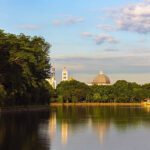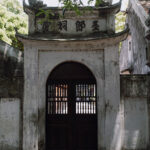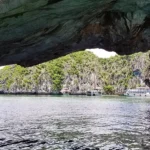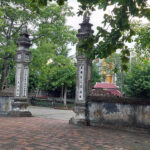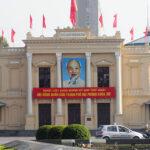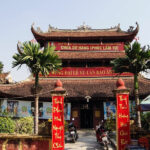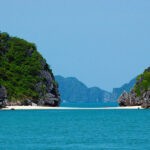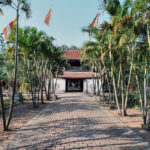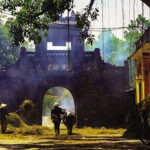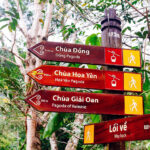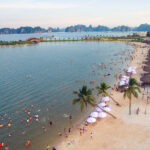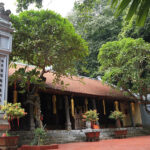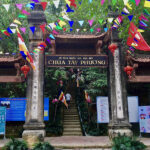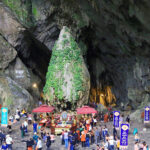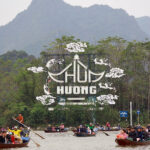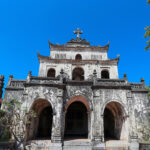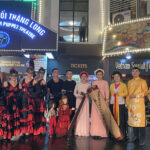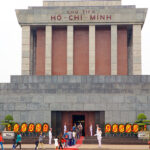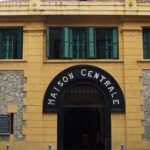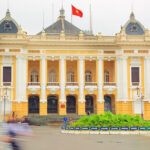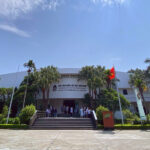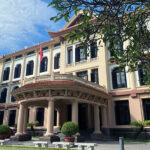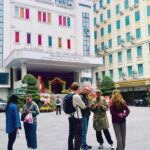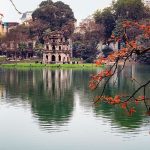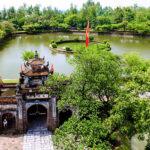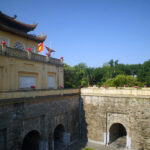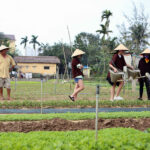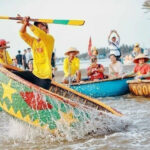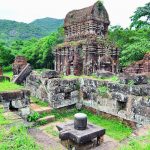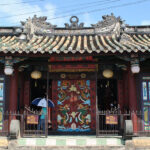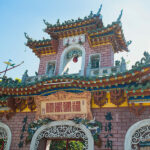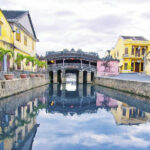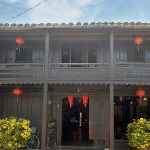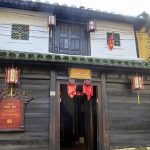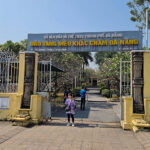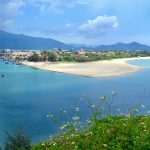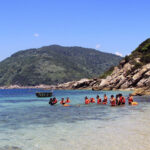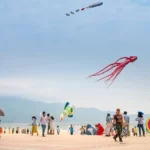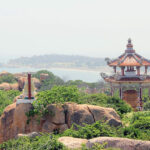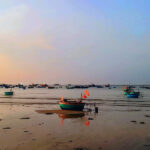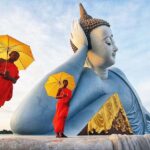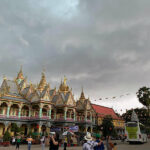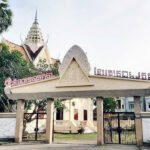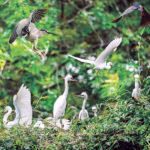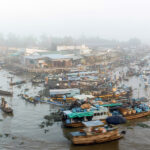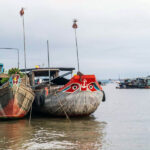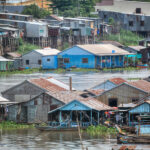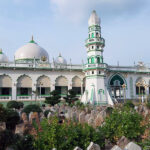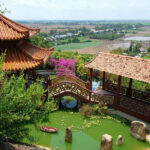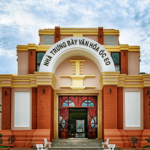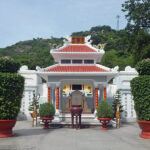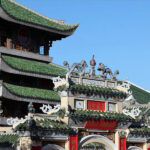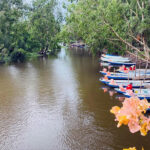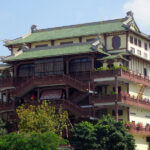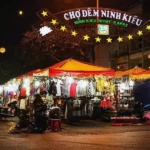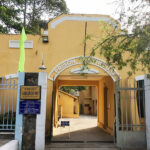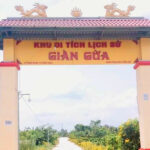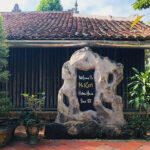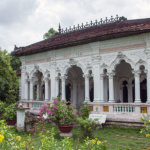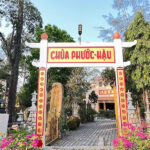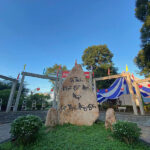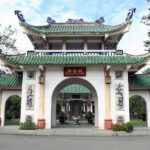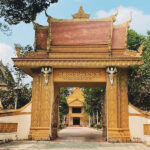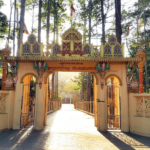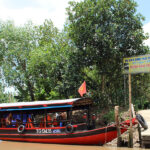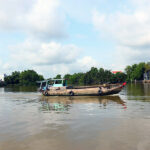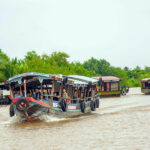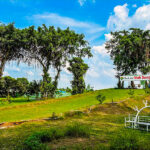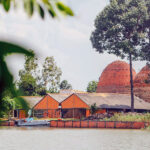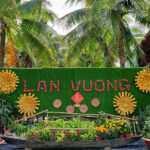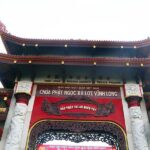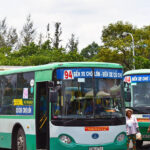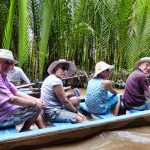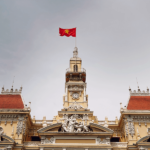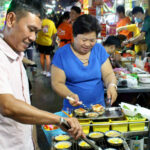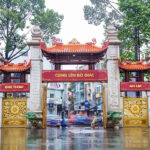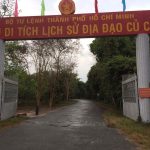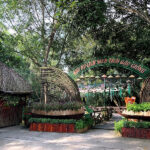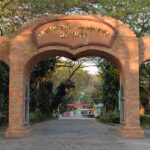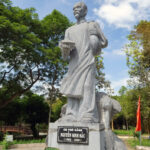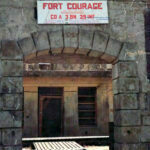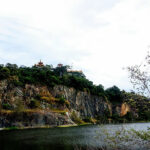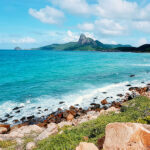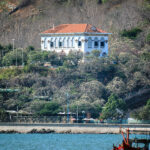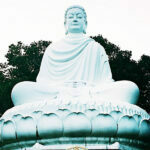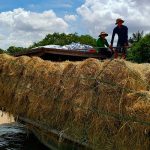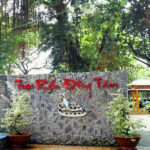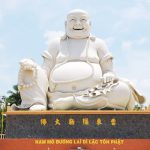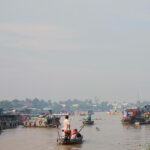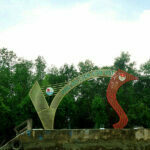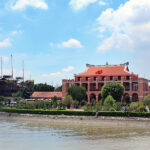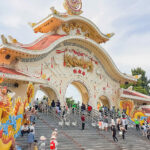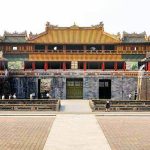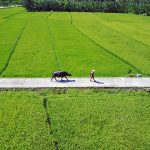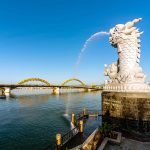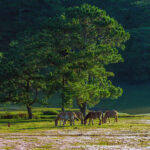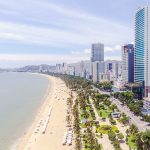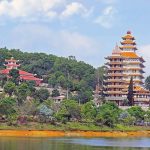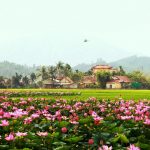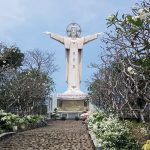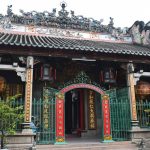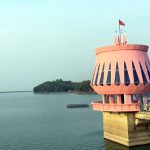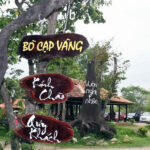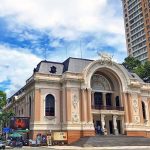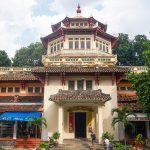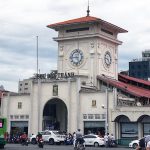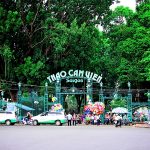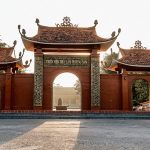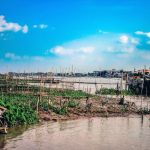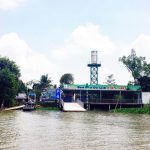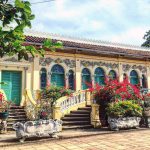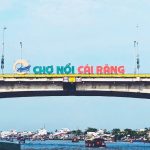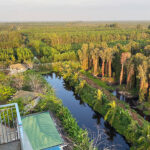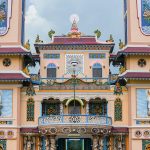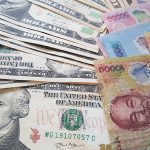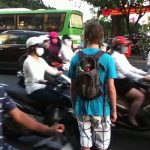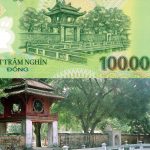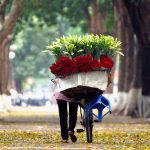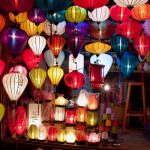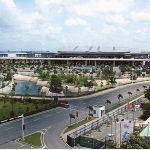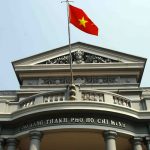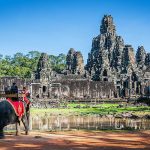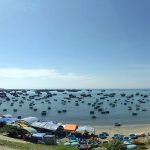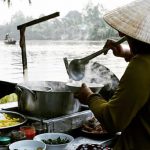Ho Chi Minh City, is one of the major cities in Vietnam, a convergence of many cultures, with diverse tourism products, a “city that never sleeps” with vibrant entertainment activities day and night.
Table of Contents
General information about Ho Chi Minh City
Ho Chi Minh City, also known as Saigon, is the largest city in Vietnam in terms of population and is the economic, entertainment center, one of the two important cultural and educational centers in Vietnam. After merging the two provinces of Vung Tau and Binh Duong into Ho Chi Minh City in 2025, the total area of the city is 6,773 km² with a population of more than 14 million people, the most populous in Vietnam.
The city currently possesses all forms of tourism, such as: urban and industrial tourism (of the old Ho Chi Minh City and Binh Duong); sea and island tourism – resort (old Ba Ria – Vung Tau), tourism combined with conferences, seminars (MICE), cultural, historical, ecological, spiritual, health tourism (such as Independence Palace, museums in Ho Chi Minh City, Con Dao prison, Truc Lam Zen Monastery, ceramic villages, fruit gardens) …
What’s the best time to visit Ho Chi Minh City?
Ho Chi Minh City is located in the tropical monsoon region near the equator. The general characteristics of the weather here are high temperatures throughout the year, with two distinct rainy and dry seasons. The rainy season is from May to November, the dry season is from December to April. The average temperature is about 27 degrees Celsius, the highest is over 40 degrees Celsius but most of the time the sun is not harsh, the humidity is low, and it is cool in the evening.
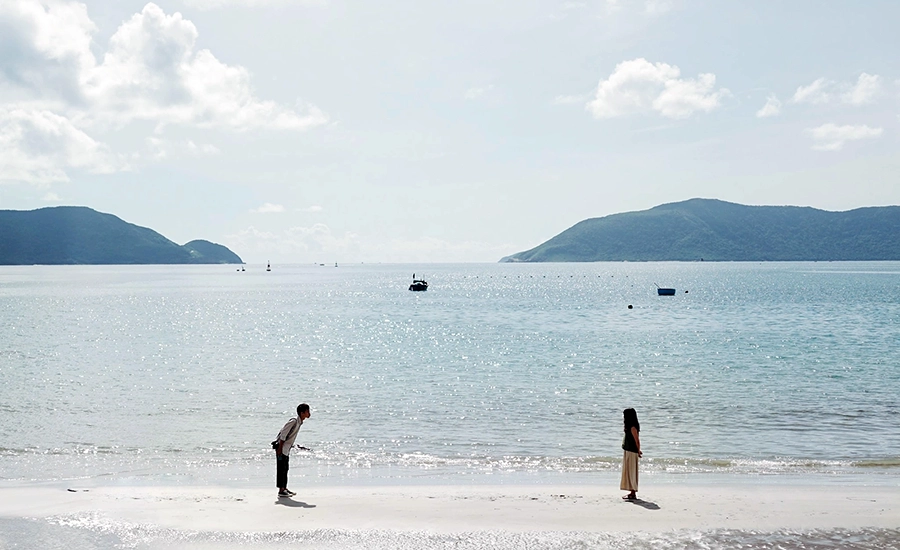
Con Dao island (photo source: collected).
The heat is not as harsh as the weather in the North, so visitors can visit the city at any time of the year. If coming in the rainy season, you should prepare an umbrella to avoid sudden showers.
How to get there and turn around?
As a big city, traveling to Ho Chi Minh City is convenient, with a full range of transportation including airplanes, trains, ships, cars, etc. Domestic airlines operate direct flights to Tan Son Nhat Airport from many localities every day. Ho Chi Minh City is the place with the highest frequency of departures and arrivals in the country.
To get Ho Chi Minh city center
Tan Son Nhat Airport is located in about 5 km from the center. Currently, the traditional taxi fare from Tan Son Nhat Airport to the center is about 250,000 VND. Visitors can book a technology car at half the price (not during rush hour).
By train, the fastest Thong Nhat train connecting Hanoi and Ho Chi Minh City is currently 30 hours, stopping at major stations such as Vinh – Dong Hoi – Hue – Da Nang – Nha Trang. Travelers should book tickets at reputable agents or directly through dsvn.vn, choose departure and arrival stations, seat type or sleeper according to their needs. Train ticket prices vary depending on the compartment and seat type.

Inside a soft-seat air condition cabin.
The main bus stations in Ho Chi Minh City include the new Eastern Bus Station (serving routes to the Eastern, Northern, Central Highlands and some Central regions), Western Bus Station (serving routes to the Southwestern region) and An Suong Bus Station (serving routes to the Northwestern, Northeastern and some Central regions). Passengers can book tickets directly at the counter, or through the websites of bus companies or reliable agents such as vexere.com; traveloka.com…
Getting around in Ho Chi Minh City
Getting around the city is convenient, with many means of transport. Renting a motorbike is one of the most popular options. Most accommodations support motorbike rental, or you can find a rental address online, popular in the central area. The daily rental price depends on the type of motorbike, ranging from 100,000 to 200,000 VND. Some places will require guests to deposit 1 to 4 million VND, some places only require personal identification documents.
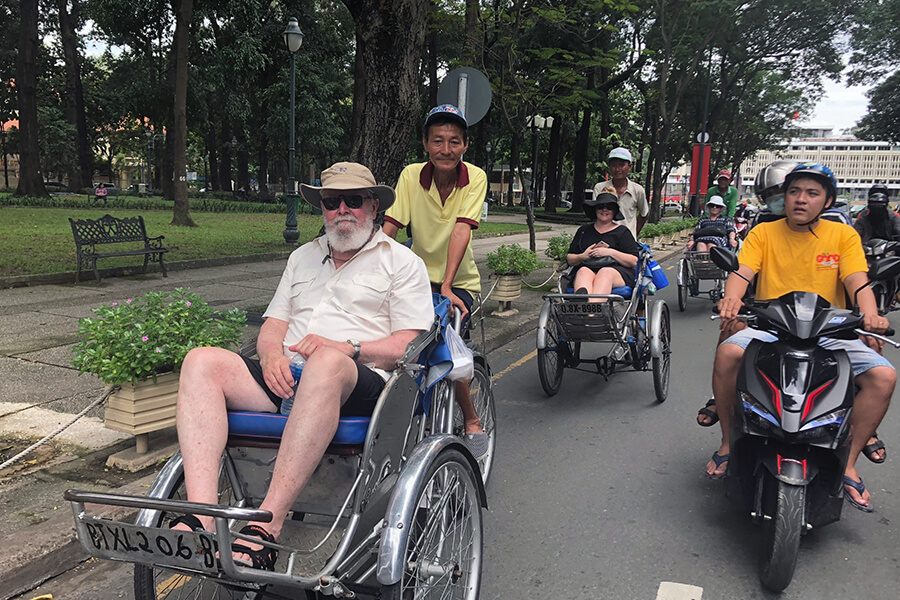
Cyclo – a means of transport loved by many tourists.
In addition, traveling by technology vehicle (car or motorbike) in Ho Chi Minh City is also a convenient option. However, if you move continuously, it will be expensive.
Public transport is a reasonable choice when you want to save costs. Visitors can choose buses or public bicycles (within the central area). Public bicycles opened in December 2021. Parking points are arranged on the sidewalks of many streets in Ben Thanh ward, near bus stops, bus shelters, parks, tourist attractions… with prices of 5,000 VND for 30 minutes and 10,000 VND for 60 minutes.
However, when you travel with a group or need to stop at many places, book a private car in Ho Chi Minh with a driver would be the best option.
To Vung Tau ward areas
From Ho Chi Minh city center, tourists can go to Eastern bus station to buy tickets directly or call to book in advance through the online system. Prices range from 100,000 to 200,000 VND per ticket, depends on type of bus you choose. Some of the popular bus companies to Vung Tau such as Kumho, Toan Thang, Phuong Trang, Thien Phu, Hoa Mai…

Greenlines speed boat to from city center to Vung Tau.
Another popular way is speed boat which takes about 1 hour and 30 minutes from Bach Dang wharf . Ticket price cost from 300,000 VND per adult with Greenlines and Pacific Express speed boat.
Accommodation in Ho Chi Minh City
Accommodation services in Ho Chi Minh City are diverse with a system of hotels, homestays, serviced apartments, meeting the needs of tourists. You can find rooms with prices ranging from a few hundred thousand to tens of millions of VND per night.
There are many 5-star hotels priced at around 3-7 million VND such as Park Hyatt Saigon, Hotel Majestic Saigon, Hotel des Arts Saigon, Pullman Saigon Centre, Hotel Nikko Saigon, Norfolk Mansion, La Vela Saigon…
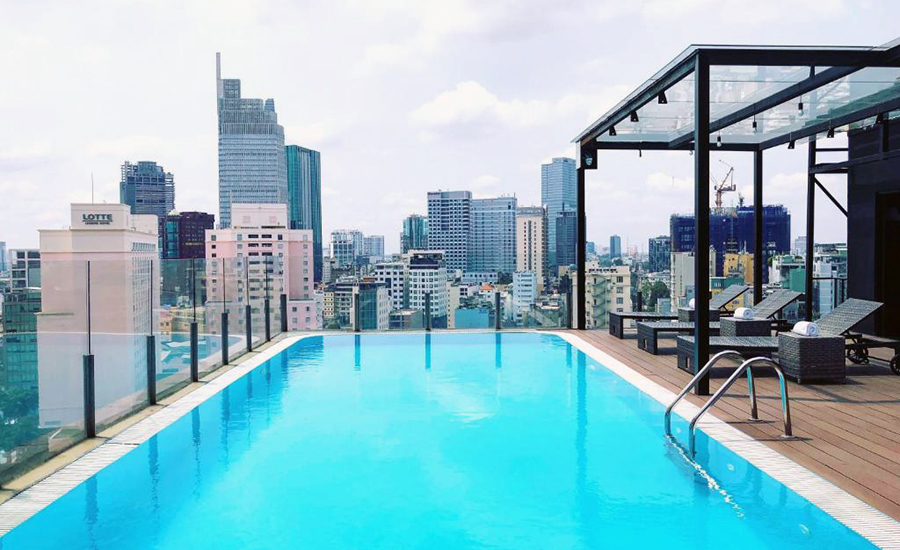
photo source (booking)
In the mid-range segment of 1-2 million VND, tourists can refer to hotels such as Wink Hotel Saigon Centre, La Memoria Hotel, The Hammock Hotel Ben Thanh, Millennium Boutique Hotel, The Odys Boutique Hotel….
Serviced apartments have full amenities like regular apartments but are beautifully decorated to suit travel needs. Some addresses that tourists can refer to include Ariosa, The Bloom, City Oasis, S Home, M Village Boutique. Serviced apartments are priced from 800,000 VND to 2 million VND.
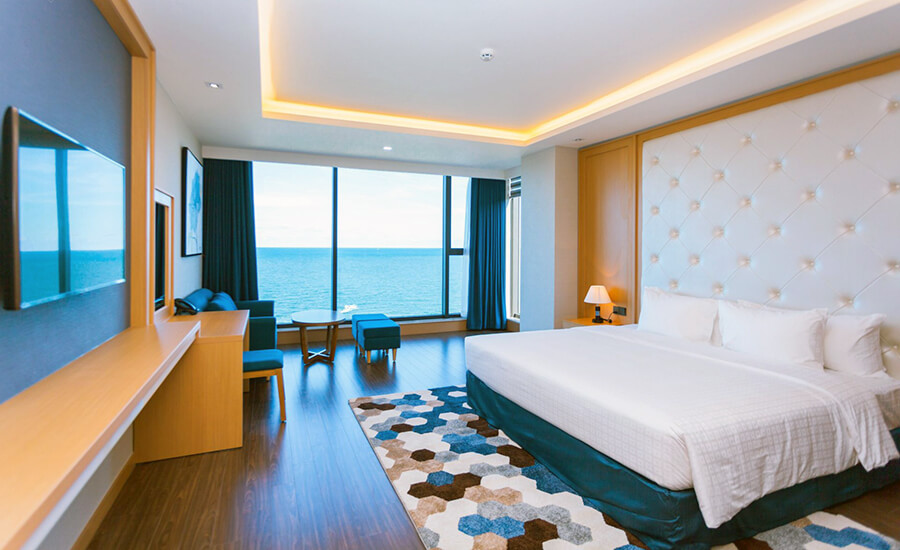
photo source (booking).
In Vung Tau ward, you should rent a room in the Back Beach and Front Beach areas to have more options and convenient travel. Room rates range from 100,000 VND to several tens of millions of VND depending on the type of hotel, motel, homestay or resort. Some high-end hotels include Pullman Vung Tau, The Imperial Vung Tau, InterContinental Grand Ho Tram, Melia Ho Tram Beach Resort, Holiday Inn Resort Ho Tram Beach…
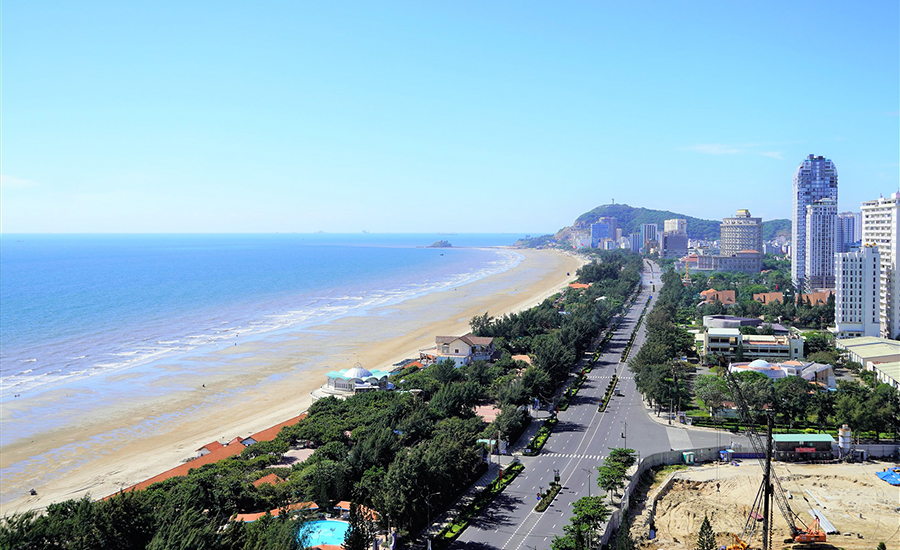
A view from a hotel in Vung Tau ward (source: booking).
If choosing Thu Dau Mot area as a weekend getaway, visitors from Ho Chi Minh City can spend the night at An Lam Retreats Saigon River located on the banks of the Saigon River. From the center of Ho Chi Minh City, traveling by river only takes about 30 minutes. Room rates for one night here start from 3 million VND.

An Lam retreats (photo source: booking).
Tourist attractions in Ho Chi Minh City
Historical and cultural relics
On the bustling streets of Saigon, it is not difficult for you to encounter architectural works with a hundred years of nostalgic beauty. Below are the most beautiful places, you can refer to
Independence Palace
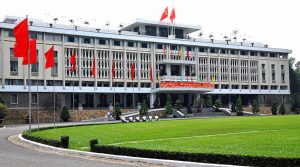
If you are looking for a day trip to Saigon associated with the culture and history of the nation, the Independence Palace will be a great suggestion for you. Originally called Norodom Palace and Palace of Indochina Governor General. It was built in 1868 and inaugurated in 1873. After 1954, Ngo Dinh Diem, South Vietnam’s President, and his family lived and worked in Norodom Palace. In 1963, this palace was heavily destroyed by bombs. President Diem commanded the remains to be destroyed and to built a new palace to be called Doc Lap Palace or Independence Palace. The new palace was built on a 120,000m² area and covered 4,500m². It included a basement, 3 mains floors, 2 mezzanies, one teeace, and one upper floor. There are total 95 rooms in the palace, each decorated according to its function. The palace also features two exhibition rooms, a 33-room guest house, and numerous entertainment service.
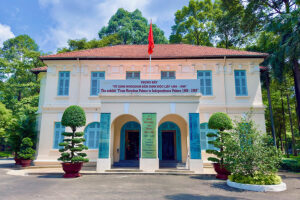 After the liberation on April 30, 1975, the Independence Palace became the headquarters of the city’s military administration committee. The political consultation for national unification was held in this place which was renamed Thong Nhat Conference Hall.
After the liberation on April 30, 1975, the Independence Palace became the headquarters of the city’s military administration committee. The political consultation for national unification was held in this place which was renamed Thong Nhat Conference Hall.
The palace is both ancient and modern, and has long become one of the symbols of the city. On weekends or major holidays like April 30, the Independence Palace is often full of visitors. Tickets to visit the Main Building and Gallery “From Norodom Palace to Independence Palace 1868 – 1966” cost from 15,000 VND to 65,000 VND. If you only visit the main building, the ticket price is 10,000 to 40,000 VND.
- Address: 135 Nam Ky Khoi Nghia Street, Ben Thanh Ward.
- Opening hours: 7:30 – 11:00 and 13:00 – 16:00 every day.
Saigon Central Post Office
 The Saigon Central Post Office was built from 1886 to 1891 and has become one of the typical architectural works in Ho Chi Minh City. The project was designed by two French architects Alfred Foulhoux and Henri Auguste Vildieu. After more than 100 years of existence, this is currently the largest post office in Vietnam that still retains its original design. A portrait of Mercury surrounded by a laurel wreath in the middle, the god symbolizing human communication put in the middle.
The Saigon Central Post Office was built from 1886 to 1891 and has become one of the typical architectural works in Ho Chi Minh City. The project was designed by two French architects Alfred Foulhoux and Henri Auguste Vildieu. After more than 100 years of existence, this is currently the largest post office in Vietnam that still retains its original design. A portrait of Mercury surrounded by a laurel wreath in the middle, the god symbolizing human communication put in the middle.
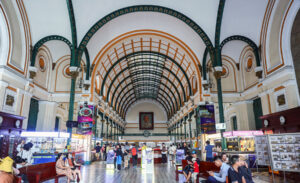 The design of the space inside the post office was influenced by the architectural style of Western European churches. The arch structure appears densely in the motifs. The dome design and meticulously calculated lighting system have created a spacious and airy space for the building.
The design of the space inside the post office was influenced by the architectural style of Western European churches. The arch structure appears densely in the motifs. The dome design and meticulously calculated lighting system have created a spacious and airy space for the building.
The post office is reminiscent of the image of Orsay train station in Paris, located alongside the Notre Dame Cathedral to form a special architectural cluster of the city.
- Address: 02 Cong Xa Paris, Sai Gon Ward.
- Visiting time: 7am to 19pm (Monday to Friday), 8am to 18pm on weekend.
- Admission: free.
Ho Chi Minh City Opera House
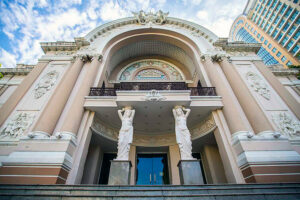 This project was carried out in 1898 and completed in 1900 under the creativity of three talented architects Félix Olivier, Eugène Ferret and Ernest Guichard, and has become a luxurious entertainment space of the city. It was inspired by two famous buildings in France, the Garnier Palace and the Petit Palais. A characteristic feature of the opera house is its arched windows with high railings, imbued with the classic inspiration of French beauty. The building’s interior decoration materials are also extremely impressive, such as shiny granite combined with crystal chandeliers and materials brought from
This project was carried out in 1898 and completed in 1900 under the creativity of three talented architects Félix Olivier, Eugène Ferret and Ernest Guichard, and has become a luxurious entertainment space of the city. It was inspired by two famous buildings in France, the Garnier Palace and the Petit Palais. A characteristic feature of the opera house is its arched windows with high railings, imbued with the classic inspiration of French beauty. The building’s interior decoration materials are also extremely impressive, such as shiny granite combined with crystal chandeliers and materials brought from  France. In particular, the opera house is the only building in the city that was roofed with Ardoise tiles.
France. In particular, the opera house is the only building in the city that was roofed with Ardoise tiles.
The architectural space of the Opera house is also impressive highlight. Currently, the opera house has a total area of up to 3,200 m² and a capacity of up to 1,800 seats. In here, you will have the opportunity to enjoy classic musicals and dances; immortal opera music by legends such as Mozart, Bahc, and Beethoven; and especially the A O Show – an inspiring combination of bamboo circus, acrobatics, contemporary dance and traditional Vietnamese music.
- Visiting time: 9:00 a.m. to 4:30 p.m. (Monday to Friday) and 9:00 a.m. to 12:00 p.m. (Saturday and Sunday).
- Address: 7 Lam Son Square, Sai Gon Ward.
Bach Dinh (White Villa)
 In 1898, Governor-General of Indochina Paul Doumer built Bach Dinh (Villa Blanche) on the foundation of Phuoc Thang fortress, which had fired on French warships nearly 50 years ago. Bach Dinh has European architecture in the late 19th century, overlooking Front Beach, surrounded by a small forest with many types of trees, especially porcelain.
In 1898, Governor-General of Indochina Paul Doumer built Bach Dinh (Villa Blanche) on the foundation of Phuoc Thang fortress, which had fired on French warships nearly 50 years ago. Bach Dinh has European architecture in the late 19th century, overlooking Front Beach, surrounded by a small forest with many types of trees, especially porcelain.
Currently, Bach Dinh is used as a museum, displaying topics such as pottery of the Kangxi Emperor period recovered from the wreck of an ancient shipwreck in the area of Hon Cau – Con Dao, cannons, and many valuable artifacts. other found through archaeological excavations in Ba Ria – Vung Tau … to Bach Dinh, visitors can enjoy the fresh air of the sea, the beautiful beauty of Bach Dinh mixed in nature, plants, and trees. and enjoy first-hand typical and rare antiques.
Location: No. 6 Tran Phu street, Vung Tau ward.
Vung Tau lighthouse

Vung Tau lighthouse was built by the French in 1862 for the purpose of navigating and signaling ships passing by, located at an altitude of 149m above sea level. By 1913, the French rebuilt this lighthouse, moving the lighthouse’s height from 149m up to 170m altitude. Vung Tau lighthouse is one of the oldest lighthouses in Vietnam and Southeast Asia.
Vung Tau lighthouse is considered as a symbol of Vung Tau ward (used to be Vung Tau City). The lighthouse architecture is a cylindrical tower 18 m high, 3 m in diameter and painted in white.
Inside the lighthouse there are stairs leading to near the top of the lighthouse and a balcony for sightseeing as well as Can Gio Port and Ba Ria beach.
Location: Located on the top of the Small mountain, Vung Tau ward
Cu Chi Tunnels
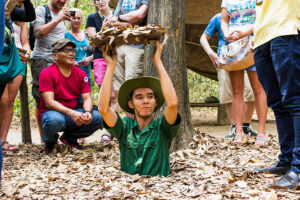 Referring to historical sites in Ho Chi Minh City, it is impossible not to miss the Cu Chi tunnels. Currently, the tunnel is one of the most tourist attractions in Saigon associated with history attracting a large number of visitors coming every day. This tourist spot was formerly a defence system, a resistance base of the Vietnamese army.
Referring to historical sites in Ho Chi Minh City, it is impossible not to miss the Cu Chi tunnels. Currently, the tunnel is one of the most tourist attractions in Saigon associated with history attracting a large number of visitors coming every day. This tourist spot was formerly a defence system, a resistance base of the Vietnamese army.
Cu Chi played an important role during the two resistance wars. It was an underground village with a network of tunnels totaling more than 250km. The main tunnel is from 60 – 70cm wides and from 80 to 90cm highs. The tunnels are approximately 3 to 10m under a layer of earth able to sustain the weight of 50ton tanks, heavy artillery, and bombs of up to 100kg.
 Cu Chi tunnels are a unique and incomparable underground city used as food and ammunition storage caches, medical care chambers, commanding chambers, meeting chambers, bedrooms, and cooking by Hoang Cam stoves…. The Vietnamese army and local people had dug and removed tens of thousands of tons of soil and stone with rudimentary tools and then camouflaged the openings so well that nobody could find them. Those who set foot in the tunnels cannot help admiring the talent, determination and endurance of the communist guerrillas. They dug and removed tens of thousands of tons of each and stone with rudimentary tools, and then camouflaged the openings so well that nobody could find them.
Cu Chi tunnels are a unique and incomparable underground city used as food and ammunition storage caches, medical care chambers, commanding chambers, meeting chambers, bedrooms, and cooking by Hoang Cam stoves…. The Vietnamese army and local people had dug and removed tens of thousands of tons of soil and stone with rudimentary tools and then camouflaged the openings so well that nobody could find them. Those who set foot in the tunnels cannot help admiring the talent, determination and endurance of the communist guerrillas. They dug and removed tens of thousands of tons of each and stone with rudimentary tools, and then camouflaged the openings so well that nobody could find them.
Currently, there are 2 different sites to visit the tunnels: Ben Dinh and Ben Duoc.
Address:
- Ben Dinh: Provincial Road 15, Phu Hiep Hamlet, An Nhon Tay Ward.
- Ben Duoc: 06 Phu My Hung Commune, An Nhon Tay Ward.
- Opening hours: 7:00 Am – 17:00 Pm, everyday.
- Admission fee: 125.000VND/a ticket for adult; free of charge for children under 1.4 meter.
Con Dao Prison
Con Dao Prison, known to many as “hell on earth”, is one of the most brutal prison systems in the world, built in Vietnam during the French colonial period, on Con Lon Island.
 Throughout historical periods, Con Dao Prison relic site has witnessed the detention and brutal torture by prison guards of thousands of political prisoners, revolutionaries, and patriots fighting against French colonialists and American imperialists.
Throughout historical periods, Con Dao Prison relic site has witnessed the detention and brutal torture by prison guards of thousands of political prisoners, revolutionaries, and patriots fighting against French colonialists and American imperialists.
Historically, the French colonial government and American imperialists built 127 prison cells, 42 solitary confinement cells, and 504 isolated cells – “tiger cages” – in the Con Dao area. After the country was completely unified (1975), the function of the prison system in Con Dao was dissolved. In 1979, Con Dao Historical Relic Site was ranked as a national relic by the Ministry of Culture and Information (now the Ministry of Culture, Sports and Tourism), with 17 component relics.
Dinh Mountain Historical area
In the early 19th century, this area consisted of primitive forests with rich flora and several kinds of precious wood. Due to its difficult and hazardous terrain, Dinh mountain was safe base for several political and military united during the French and American resistance wars.
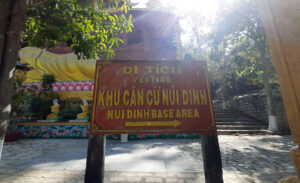 Day Bi Cave: the cave was the base where leading political and military units of Chau Duc District hid during wartime
Day Bi Cave: the cave was the base where leading political and military units of Chau Duc District hid during wartime
To cave: situated at 200m above sea level. To cave is linked to a deep network of grottoes. During the resistance period, the cave was used as a site of cadres and militants as well as a food warehouse.
Mai Cave: Mai cave is a beautiful site situated at a height of 234m, over a large valley with two small streams running through it. By 1968, the base as well as many of the pagodas in the area had been bombed and destroyed. At one point, the enemy positioned troops close to the opening of the cave and crashed it down.
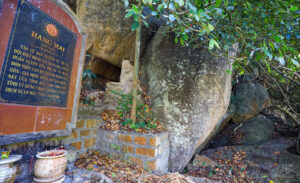 Lung Small Valley: this mall valley used to be a remote resistance base, hidden in an area where edible plants grew in abundance. Old trees of all kinds also grew on the slopes. Cadres and militants lived in underground shelters to ward off bombings. This was also the training base for resistance forces of Ba Ria and Saigon’s Youth League.
Lung Small Valley: this mall valley used to be a remote resistance base, hidden in an area where edible plants grew in abundance. Old trees of all kinds also grew on the slopes. Cadres and militants lived in underground shelters to ward off bombings. This was also the training base for resistance forces of Ba Ria and Saigon’s Youth League.
Dieu Linh Pagoda: perched at a height of 160m, this pagoda was shelter for the leading agents of Ba Ria but it was destroyed by bombings.
Bat Cave: situated at a height of 50m, Bat cave was another base of leading and commanding agents of Ba Ria’s forces during both long resistance wars. This cave has been opened to the general public.
 Dinh Co Palace: according to legend, Dinh Co palace was built in the late 18th century and dedicated to the virgin Le Thi Hong who died in the sea. Her body was carried by the waves and drifted ashore on Hang island where she was buried by villagers on a hillock on the coast. Because her spirit kept appearing to the local to predict events and cure them of diseases, the villagers set up a shrine in her honour.
Dinh Co Palace: according to legend, Dinh Co palace was built in the late 18th century and dedicated to the virgin Le Thi Hong who died in the sea. Her body was carried by the waves and drifted ashore on Hang island where she was buried by villagers on a hillock on the coast. Because her spirit kept appearing to the local to predict events and cure them of diseases, the villagers set up a shrine in her honour.
At first, the Dinh Co was only small shrine located near the shore. By 1930, villagers had collected funds and constructed a larger palace. Today, Dinh Co is a vast, splendid and solemn palace. The inside is decorated with statues of the four sacred animals. The Dinh Co Festival is celebrated on the anniversary of the death of Le Thi Hong from the 10th to the 12th of the 2nd lunar month. As a result of its beautiful natural plandscapes of mountains, forest, sea, and beach, along with its exceptional architecture and inner design, Dinh Co has been listed as a National Heritage Site.
Museum systems
Ho Chi Minh City ranks first in Vietnam in the number of museums, with diverse topics from history, culture, tradition, celebrities, art and medicine.
War Remnants Museum
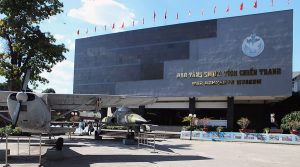
Currently, the War Remnants Museum is displaying a lot of documents, artefacts as well as real and vivid images about the period of the war against aggression and the consequences it left on the country and Vietnamese. It can be said the War Remnants Museum is the historical museum that leaves the most emotions for visitors. What is displayed in the museum reflects too faithfully the image of Vietnam during the colonial period. With more than 20,000 photos, artefacts and films are kept, in which artefacts such as the “tiger cage”, and the Viet Minh guillotine killing machine show the cruelty of war. There are also many other impressive artefacts such as Agent Orange.
On the yard outside of the building, there are tanks, planes, helicopters, cannons, etc., which were once fought in the air to repel the US.
- Address: 28 Vo Van Tan Street, Xuan Hoa Ward.
- Opening hours: 7:30 Am – 17:30 pm, every day.
- Entrance fee: 40,000 VND per person, children under 6 years old are free.
Dragon House Wharf – Ho Chi Minh Museum

Dragon House Wharf was formerly the headquarters of the Transport Corporation (Messageries Impériales) – one of the first works built by the French colonialists after capturing Saigon. The wharf was built in the middle of 1862 and completed in 1863 with Western architecture. However, on the roof, two dragons are attached to the moon according to the motif of “Two dragons adoring the moon” – a familiar decoration of Vietnamese temples.
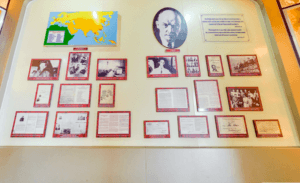 With this unique architecture, the wharf is also known as “Nhà Rồng” – (Nhà means house, Rồng means Dragon). A particularly significant event related to the port of Saigon on June 5, 1911, Uncle Ho (later known by his famous name – Ho Chi Minh) got off the Amiral Latouche Tréville ship from this wharf, to go abroad to find a way to save the country. He travelled through France and many countries with many different continents. And after 30 years, he returned to the country, leading the Vietnamese people to stand up to liberate the nation and reunification of the country.
With this unique architecture, the wharf is also known as “Nhà Rồng” – (Nhà means house, Rồng means Dragon). A particularly significant event related to the port of Saigon on June 5, 1911, Uncle Ho (later known by his famous name – Ho Chi Minh) got off the Amiral Latouche Tréville ship from this wharf, to go abroad to find a way to save the country. He travelled through France and many countries with many different continents. And after 30 years, he returned to the country, leading the Vietnamese people to stand up to liberate the nation and reunification of the country.
To remember the above event, after the unification of the country, the Dragon Wharf was rebuilt into a memorial park of President Ho Chi Minh, with the task of collecting, preserving, displaying and propagating transmitting about the life and career of the President the basis of documents and artefacts of the Museum.
- Address: No. 01 Nguyen Tat Thanh, Ward 12, District 4.
- Opening hours: 7:30 Am – 11:30 Am; 13:30 – 17:00 Pm, everyday.
- Admission ticket: 20.000VND/1 ticket.
Vietnam History Museum
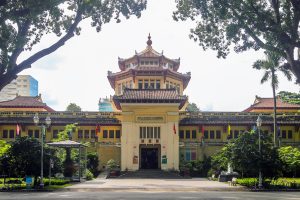
Vietnam History Museum was established on January 1, 1929, with the name Blanchard de la Brosse Museum. At the time of opening, the museum only had 2,893 antiques, but over time, until now, the museum has more than 30,000 valuable artefacts and 25,000 books and documents. The function of the museum is to preserve and promote the cultural heritage of the nation through research, collection, assessment, restoration, etc.
The museum is open to visitors those who wish to learn about documents and artefacts related to the history of Vietnam, especially the southern provinces.
Furthermore,, the Ho Chi Minh Museum also keeps a lot of memorabilia from the Stone Age, Bronze Age, etc. Many ancient works of art are on display and are in quite an intact condition helping visitors understand the ancient culture of the ancient Vietnamese. If this is your first time coming to the Ho Chi Minh City Museum of History, you will surely be captivated by these ancient works of art.
- Address: No. 2, Nguyen Binh Khiem, Sai Gon Ward.
- Opening hours: 8:00 Am – 11:30 Am; 13:00 Pm – 17:00 Pm from Tuesday to Sunday; close on Monday.
- Admission ticket: 30,000 VND per person, children under 6 years old are free.
Museum of Ho Chi Minh City

With an area of 1,700 m², the Ho Chi Minh City Museum is a large building displaying and storing antiquities, artefacts, historical and cultural evidence, etc. of the city as well as of Vietnam. The museum has 10 rooms, each displaying different artefacts, including rooms “Nature – archaeology”, “Geography – administration Saigon – Ho Chi Minh City”, “Trading port, Trade” – services”, “Industry and handicrafts”, “Saigon culture – Ho Chi Minh City”, “Revolutionary struggle 1930 – 1954”, “Revolutionary struggle 1954 – 1975″, ” Resistance material” and “Vietnamese money”.
Not only is it a place to store antiquities, but the Ho Chi Minh City Museum also leaves an impression on visitors through its unique architecture, designed in the style of the classical – renaissance, combining Europe – Asia. Therefore, when visiting the museum, in addition to learning about culture and history, you can also keep beautiful pictures right outside the museum.
- Address: 65 Ly Tu Trong, Sai Gon Ward.
- Opening hours: 8:00 Am – 17 Pm, everyday.
- Admission ticket: 40,000 VND per person, children under 6 years old are free.
South-Vietnamese Women Museum

The Southern Women’s Museum, established on April 29, 1985, is one of the museums that preserve photos and artefacts showing the lives of Southern women during the war to protect the country. Currently, the museum is storing and managing 31,360 artefacts, but only displays 929 of the most typical artefacts due to the limited space. Also, 2/3 are artefacts of the type of revolutionary war, and the remaining 1/3 show the culture of Southern women.
These artefacts are divided into several collections according to a certain theme or material. In addition, in the library room of the museum, over 11,000 books about women’s topics are kept. This would be a favourite destination for those who want to study Vietnamese females when travelling to Ho Chi Minh City.
- Address: 202 Vo Thi Sau Street, Xuan Hoa Ward.
- Opening hours: 7:30 Am – 17:00 Pm
- Admission ticket: free
Museum of Traditional Medicine

The Museum of Traditional Medicine is one of the first private museums in Vietnam, with an architectural style from the North but located in the centre of Ho Chi Minh City, helping to leave a new impression on visitors. The museum was put into use in 2007, with 18 galleries in a modest area of 600 m². Although it is a private museum, the number of artefacts still can make you feel surprised with more than 4,000 artefacts related to Vietnamese traditional medicine and 1112 names of medicines. Some artefacts have been existing for a long time, or precious tools that the great physician Hai Thuong Lan Ong – Le Huu Trac had used.
Not only seeing artefacts and unique architecture, coming to the Museum of Traditional Medicine, visitors can also participate directly in the preparation process of the ancients including stages such as cutting medicine, spreading, or even tasting medicine. And if you’re “sick” and need some advice with medicine, yeah, you can get it directly from reception.
- Address: 41 Hoang Du Khuong, Hoa Hung Ward.
- Opening hours: 8:30 Am – 17:00 Pm
- Admission: free
Saigon Ranger Museum
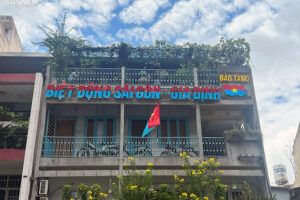
The Saigon Ranger Museum is located in a three-story house built in 1963 on Tran Quang Khai Street. During wartime, this location was the place to carry out secret missions of the Saigon rangers such as meetings; exchanging letters and documents; and providing gold coins to the war zone, under the management of Mr. Tran Van Lai (also known as Nam Lai). The museum has been operating since December 24, 2019, with an area of more than 100 m2, displaying more than 300 artifacts of special forces soldiers, including daily living items, transportation vehicles of liaison soldiers, weapons used in major battles, tunnel systems and military maps – clearly describing secret tunnels, bunkers and US military bases in the city, tools for communication, printing press to distribute leaflets… The house’s original architecture has been preserved, and most of the items are still intact. In addition, visitors can watch short films and images of some raids on the enemy by Saigon ranger force.
- Address: 145 Tran Quang Khai Street, Tan Dinh Ward.
- Visiting hours: from 7:00 a.m. to 17:30 p.m every day.
- Admission: free.
Ao Dai Museum

Ao Dai is the traditional dress of the Vietnamese people, but have you really seen the Ao Dai a few centuries ago? Fortunately, Ao Dai Museum had built by a painter and designer – Sĩ Hoàng, inaugurated on January 22, 2014. The main purpose of the museum is to display artefacts, conduct research, and collect and store documents, and images about Ao Dai that are associated with Vietnamese women from the past to the present. Currently, the museum has more than 1,000 sets of Ao Dai, but only about 100 are displayed with diverse designs and materials. The remaining them will be given out according to each specific exhibition with a certain theme.
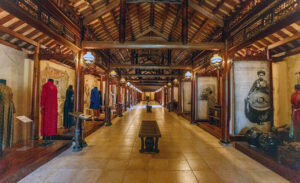 Most of the Ao Dai sets, in the museum, are associated with famous Vietnamese women in many fields such as Armed Forces Hero Nguyen Thi Dinh, Vice President Nguyen Thi Binh, and People’s Artist Bay Nam,… Besides, the museum also displays about 3,000 images of Vietnamese women in traditional costumes throughout the development periods of the country.
Most of the Ao Dai sets, in the museum, are associated with famous Vietnamese women in many fields such as Armed Forces Hero Nguyen Thi Dinh, Vice President Nguyen Thi Binh, and People’s Artist Bay Nam,… Besides, the museum also displays about 3,000 images of Vietnamese women in traditional costumes throughout the development periods of the country.
The museum is designed in ancient architecture with a wooden frame and yin & yang tile roof. The interior space is divided into two parts: the right side of the entrance displays the Ao Dai dresses from each period and the left side is the real dresses that have been associated with Vietnamese women who have made great contributions in the main fields.
- Address: 206/19/30 Long Thuan, Long Phuoc Ward.
- Opening hours: 8:30 Am – 17:30 Pm.
- Admission: 50,000VND/a ticket for a adult; 30,000VND/a ticket student/child.
Worldwide Arms Museum

The Worldwide Arms Museum was founded by Mr. Robert Taylor (British nationality) and his wife Nguyen Thi Bong. According to the visitors, this is one of the most worth seeing museums in Vietnam. Opened in early 2012, the museum displays 500 life-size dummies, wearing beautiful military uniforms, representing warriors from all over the world in many periods; more than 1,200 guns, 1,000 ancient swords with history, and other interesting stories.
Coming to the museum, you will discover the historical values of each period from ancient to modern. Visiting the ancient area, you will be amazed at the collection filled with weapons from the Roman Empire, Genghis Khan or Samurai such as swords, spears, bayonets, along with the costumes, armor, helmet.
Location: No. 98 Tran Hung Dao, Vung Tau Ward. Opening time to welcome visitors from 08:00 to 17:00 daily.
Suburban destination
Located just dozen kilometers from the center of Ho Chi Minh City, these locations are ideal places that attract not only foreign tourist but also local come to visit and explore.
Can Gio
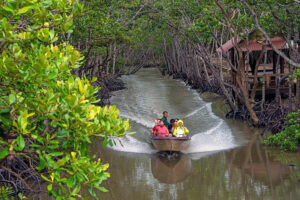
Can Gio is located about 50 km from the city center, has a terrain including forests and sea, with many ecotourism activities that can be experienced during the day. Can Gio is the only district in Ho Chi Minh City bordering the sea and is also the first mangrove forest in Vietnam recognized as a world biosphere reserve.
Here, visitors will travel by canoe in the mangrove forest to visit the Rung Sac revolutionary base; relics and learn about the lives, battles and achievements of special forces soldiers during the war; admire the natural monkey population; canoe on the river to Vam Sat eco-tourism area, row a boat to visit a bat conservation area;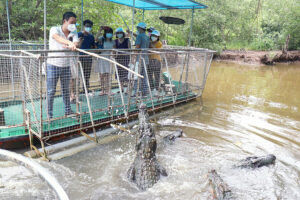 visit the bird sanctuary, experience the feeling of adventure when going on a crocodile fishing boat; conquer a 26 m high tower for panoramic views of the mangrove forest.
visit the bird sanctuary, experience the feeling of adventure when going on a crocodile fishing boat; conquer a 26 m high tower for panoramic views of the mangrove forest.
In Can Gio, there is a local market, considered a “seafood paradise” with many types of fresh shrimp, crabs, snails, and squid at affordable prices. You can choose fresh oysters, snails, crabs, shrimp, and squid and have the seller directly process it on the spot at a cost of several tens of thousands of VND per dish.
Transportation: Visitors can travel by motorbike, car, or bus go to Binh Khanh ferry terminal and buy a ferry ticket to reach Can Gio area.
Binh Chau – Ho Coc Eco-tourist Site
Located in Xuyen Moc Commune, about 150km from Ho Chi Minh center, this tourist site is endowed with beautiful landscapes. Bang stream, Binh Chau primitive forest, Ho Coc beach and Binh Chau thermal spring are tourist sites that attract a lot of tourists.
 Binh Chau thermal spring stands out from the green background of primitive forest. With the temperature of 37ºC to 82ºC and the high contents of natri, clo, nito, silic and sulphur, Binh Chau is known as a good place for relaxation and disease treatment. The area also has a resort with swimming pools, golf course and mud and mineral water pools. In addition, there is an open-air stage with more than 1000 seats and bungalows made of bamboo and wood. Especially, tourist can take part in hunting party at night in hunting-ground.
Binh Chau thermal spring stands out from the green background of primitive forest. With the temperature of 37ºC to 82ºC and the high contents of natri, clo, nito, silic and sulphur, Binh Chau is known as a good place for relaxation and disease treatment. The area also has a resort with swimming pools, golf course and mud and mineral water pools. In addition, there is an open-air stage with more than 1000 seats and bungalows made of bamboo and wood. Especially, tourist can take part in hunting party at night in hunting-ground.
Close to Binh Chau primitive forest is Ho Coc beach that attract a lot of tourist by resorts. Binh Chau thermal spring is attractive site for those who love nature and who want to relax in an enchanting environment. Visitors to this site can enjoy frest air, wallow in mineral water and take part in recreation activities.
Con Dao National park
 Con Dao national park with an area of 19,998 hectars is founded on March 31, 1993 in Con Dao island, Vung Tau ward. The park’s terrain is primarily hills and mountains. The highest peak, 557m is called Thanh mount and the other peaks are 150-300m high. The weather is characterized by tropical monsoons with direct influence from oceanic climate, the average temperature during the year is 26ºC, the mean humidity 90%. The ecosystem is classified as island tropical forest and is divided into two main types of woods. The flora includes 882 high class plant species. A new plant species are considered rare and precious including lat hoa, gang neo, gang long, ect. Con Dao has 144 species, 14 of which are in the group of precious rare animals. In comparison with other natural parks, Con Dao has a land vertebrate fauna of global significance. The sea at Con Dao contains three premary
Con Dao national park with an area of 19,998 hectars is founded on March 31, 1993 in Con Dao island, Vung Tau ward. The park’s terrain is primarily hills and mountains. The highest peak, 557m is called Thanh mount and the other peaks are 150-300m high. The weather is characterized by tropical monsoons with direct influence from oceanic climate, the average temperature during the year is 26ºC, the mean humidity 90%. The ecosystem is classified as island tropical forest and is divided into two main types of woods. The flora includes 882 high class plant species. A new plant species are considered rare and precious including lat hoa, gang neo, gang long, ect. Con Dao has 144 species, 14 of which are in the group of precious rare animals. In comparison with other natural parks, Con Dao has a land vertebrate fauna of global significance. The sea at Con Dao contains three premary  ecosystems; mangrove foreest, marine grass cover, and coral reefs. Marine species are quite numerous with 1321 species, 37 of which are listed in Vietnam’s Red Book. Scientists also find there a few rare fishes such as the blue whale, and dugong. Especially, sea turtles are large in quantity.
ecosystems; mangrove foreest, marine grass cover, and coral reefs. Marine species are quite numerous with 1321 species, 37 of which are listed in Vietnam’s Red Book. Scientists also find there a few rare fishes such as the blue whale, and dugong. Especially, sea turtles are large in quantity.
The Con Dao National park’s marine environment and forest resources are in rather good conditions. Its bio-diversity is highly potential and natural landscape is well preserved. The park is also famous among Vietnamese for its fine and strange marine species. Visitors are offered a wide range of tours from eco-tourism to adventurous tours (climbing, going fishing, diving, trekking, riding bicycles, sightseeing cum-research).
Thu Dau Mot area
From the center of Thu Dau Mot ward, within a radius of about 40 km, old Binh Duong has many places to have fun and explore, typically: Iron Triangle Tunnel, Hoi Khanh Pagoda, Phu Cuong Cathedral, Tuong Binh Hiep lacquer craft village, Phu An bamboo village, Hong Van fruit garden, Fito Museum….
Especially, located in Chanh Hiep ward, Dai Nam tourist area has a total operating area of about 260 hectares, is one of the largest tourist areas in Southeast Asia. Here there are full mountain, river and lake views and many entertainment services such as Kim Dien, Dai Nam beach, thrilling game area, zoo with open design, hotel with full amenities. Besides, Dai Nam racetrack is considered the driving force and highlight of the whole area. Dai Nam is open every day of the week from 8am to 17pm.
Pilgrimage sites
Not only is it the most dynamic city in the country, Ho Chi Minh City is also a cultural and spiritual place that gathers many beautiful and sacred temples. Visiting a pilgrimage site would help you relax, get some peaceful moments and also a great chance to admire in the unique architecture of the building.
Notre Dame Cathedral
Located in the heart of Saigon, the majesty and magnificence of Notre Dame Cathedral make everyone burst into wonder at its beauty. It was built in an extremely unique European-Romanesque style. All of the bricks and tiles are brought from France. And on each brick, there are also the names of the units that have been produced. Thanks to the high-quality construction materials, after hundreds of years, this historical monument in Ho Chi Minh City still retains its integrity.
Currently, Notre Dame Cathedral is in the process of being remodelled, visitors can only take pictures, visit the outside and not enter the church.
Address: 01 Cong Xa Paris, Sai Gon Ward.
Vinh Nghiem Pagoda
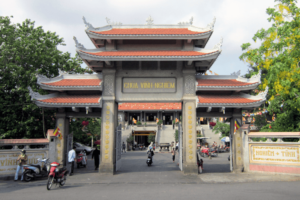
The Vinh Nghiem Pagoda has a distinct architecture with spacious and airy space. The pagoda is noteworthy for its ancient Asian architecture and seven-story tower. The corners of the pagoda roof are curved in the Northern style, in the middle of the roof, there is a Falcon and the corners of the pagoda are carved with the shape of a phoenix head. The pagoda also has a community Xa Loi tower to keep the ashes of the deceased that were sent at the temple.
Just stepping through the Tam Quan gate, visitors can witness firsthand the magnificence of the largest stone tower in Vietnam with a height of up to 14m. Not stopping there, Vinh Nghiem Pagoda also has a community Xa Loi tower to store the ashes of the deceased sent at the temple. It is also for this reason that every year many people come to remember their loved ones.
Address: 339 Nam Ky Khoi Nghia, Nhieu Loc Ward.
Thien Hau Temple
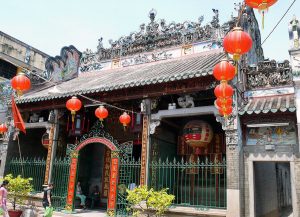
This is a Chinese temple with the longest history among the temples in Ho Chi Minh City. The temple has bold Asian architecture, including 4 buildings arranged in the shape of the word “Quốc”(meaning: National). This place keeps embossed paintings of the four spirits – “Dragon, Unicorn, Turtle, Phoenix” and more than 400 other rare antiques. The eaves, roofs and walls are decorated with reliefs made of baked ceramics, exuding the majesty and grandeur of the temple. Another special feature that few people know about is that all the materials use to build Thien Hau Temple were transported from China. Therefore, the temple has great artistic and technical value. It’s also a place of spiritual and cultural activities of the Hoa people in Ho Chi Minh City.
Ba Thien Hau Pagoda is located at 710 Nguyen Trai, Cho Lon Ward.
Vietnam Quoc Tu
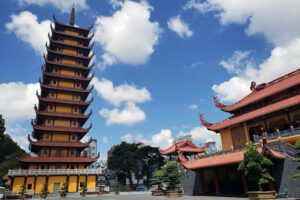
Vietnam Quoc Tu is famous for its pure; peaceful space with unique and outstanding architecture. Covering the pagoda are the shadows of large old trees, shady and green all year round. At the corner of the pagoda, there is the tallest tower in the country with 13 floors and a height of up to 63m. The pagoda has historical and spiritual significance for the Vietnamese.
The 7-floor tower displays Buddha statues for Buddhist monks and nuns, tourists come to offer incense and worship. Currently, Vietnam Quoc Tu is chosen as the new headquarters of the Vietnam Buddhist Association, attracting many tourists who come to visit and pray for peace.
Address: No 244 Road 3/2, Hoa Hung Ward.
Mariamman Hindu Temple

The Mariamman Temple, located near Ben Thanh market, is also one of the oldest and most famous Indian temples in Ho Chi Minh City. It was designed and built with a strong influence of Hindu, worshipping the Rain God – Mariamman. This is not only the legacy of the Indians who used to live in this land, but also a community area of Indians who live and work far from their homeland. It was really a spiritual place during their time living in Saigon. Coming inside the temple, along the stone wall are statues of 18 gods – symbolizing the wishes of the people. Therefore, whatever the problem, especially about illness, children, and safety….they will come here, put their heads down to confide in the stone wall and receive the sounds of peace and serenity for themselves.
Address: 45 Truong Dinh, Ben Thanh Ward.
Xa Loi Pagoda
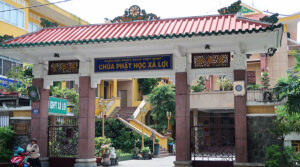
Xa Loi Pagoda was built according to the new architecture in Vietnam with the upper part being the worshipping hall and the lower part being the lecture hall. The pagoda owns a bell tower with a height of 32 meters – the tallest bell tower in Vietnam, with a big bell that weighs up to 2 tons. Along with the 7-storey bell tower, the main hall is the area with the most characteristic architecture of Xa Loi Pagoda.
The main hall has an area of more than 400 square meters, spacious, airy and “catching” all the light from nature. The pagoda was built to worship the relics of the Buddha, including the main hall to worship Shakyamuni Buddha and many different areas such as the library, the lecture hall…
Address: 89 Ba Huyen Thanh Quan, Xuan Hoa Ward.
Thich Ca Phat Dai

Thich Ca Phat Dai is a notable Theravada Buddhist pagoda in Vung Tau, located on the Large Mountain of Vung Tau City. The beauty of the pagoda cleverly combines religious architecture and natural landscape.
The most noteworthy is the 19m- Bat Giac tower (Octagonal Tower) and the Shakyamuni statue meditating on a lotus building, halfway up to the mountain slope. Standing from afar, visitors can also admire the statue. Along the path up to the pagoda, the way is decorated with various statues that depict important events in the life of Gautama Buddha: his birth as Prince Siddhartha, his renunciation of the world, the enlightenment under the bodhi tree at Bodh Gaya, the first sermon at Sarnath and the passing into final Nibbāna at Kusinara.
In addition, the pagoda also has a 17 m high Xa Loi stupa, inside is a golden box containing 13 relics of a true monk. At the foot of the stupa are four large peaks, in which are placed sacred soil brought back from the place where the Buddha was born.
Location: 608 Tran Phu street, Vung Tau Ward. The pagoda opens from 6 am to 18 pm every day.
Christ of Vung Tau
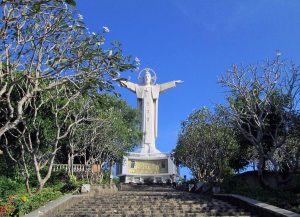 The statue of Christ outstretched arms on top of Nho Mountain, built-in 1971. The statue was established as “The largest statue of Jesus in Asia” in 2012. The Christ of Vung Tau is 28 m high, 18.3 m long arm span above 170 m overlooking the sea. Inside is a spiral staircase with 133 steps and accommodate 100 visitors at the same time.
The statue of Christ outstretched arms on top of Nho Mountain, built-in 1971. The statue was established as “The largest statue of Jesus in Asia” in 2012. The Christ of Vung Tau is 28 m high, 18.3 m long arm span above 170 m overlooking the sea. Inside is a spiral staircase with 133 steps and accommodate 100 visitors at the same time.
The statue can be seen as a similar version of the Christ with arms open in the city of Rio de Janeiro in Brazil. The halo around the statue’s head is also an important physical device: it is the first part of the lightning rod to prevent lightning. 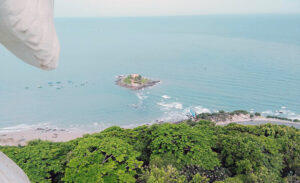 The statue’s robe has 3 windows decorated with longevity patterns, helping the statue’s interior to be naturally lit and ventilated.
The statue’s robe has 3 windows decorated with longevity patterns, helping the statue’s interior to be naturally lit and ventilated.
From the statue’s shoulders, visitors can see the whole view of Vung Tau: Big Mountain, Dau Beach, Truoc Beach, Dua Beach, Sau Beach, Chi Linh Beach, Thuy Tien Beach, Sen Lake, Trung Lake… Also from that high point, people can see quite a full part of the East Sea.
Location: 01 Ba Ria, Vung Tau Ward. Opening hour from 5:30 am until 17pm.
Best beaches
Long Hai
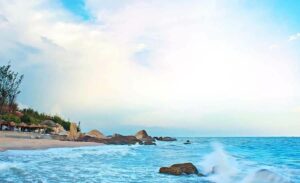
Ho Tram beach, Ho Coc beach, or Binh Chau hot spring are all famous tourist destinations of Long Hai Commune, about 12km from Vung Tau ward, is also an ideal choice for traveling and relaxing next to Vung Tau.
As mentioned above, this place has many famous landmarks, the most typical being Long Hai beach with its long stretch of fine golden sand. Thanks to the moderate slope of the sandy beach, tourism services are relatively developed and the number of tourists is not too large.
Long Hai seafood is fresh and delicious at affordable prices. Besides Long Hai beach, there are other attractions such as Dinh Co temple, Dinh Co beach, Monkey pagoda, Minh Dam mountain…
Vung Tau Beaches
 Vung Tau has 42 km of coastline, of which the longest and most beautiful is Back Beach, stretching nearly 10 km, located in the south of the city. Back Beach, also known as Thuy Van, is one of the most beautiful beaches in Vietnam with smooth, straight white sand beaches.
Vung Tau has 42 km of coastline, of which the longest and most beautiful is Back Beach, stretching nearly 10 km, located in the south of the city. Back Beach, also known as Thuy Van, is one of the most beautiful beaches in Vietnam with smooth, straight white sand beaches.
Next is Front beach, also known as Tam Duong beach because it is located in the west, where you can watch the sun set over the sea.
 Vung Tau also has Pineapple beach, where the sea creeps deep into the shore, creating rocky rapids stretching out to the sea, and at the same time forming private, poetic bathing pools.
Vung Tau also has Pineapple beach, where the sea creeps deep into the shore, creating rocky rapids stretching out to the sea, and at the same time forming private, poetic bathing pools.
Bai Dau is windy with many interesting rapids and rocks. The pristine Vong Nguyet beach is located at the foot of Small Mountain, with majestic cliffs on three sides, for those who like to explore and experience…
However, the beaches in Vung Tau are often overloaded during holidays and Tet. If you go during the peak season, you should carefully preserve your personal belongings and belongings and not go too far from shore. After having fun in the sea, you can take the time to watch the sunset and rest.
Entertainment activities
Ho Chi Minh City tourism aims to have a tourism product for each ward. The city has a variety of entertainment activities, entertainment areas, sightseeing, and shopping suitable for many types of visitors.
Take the river bus
 Experiences on the river are a feature of Ho Chi Minh City tourism. Visitors can see the city from a different perspective, through many famous landmarks such as Nha Rong Wharf, Ben Nghe Port, Phu My Bridge, Den Do Cape, and Binh Khanh Ferry Terminal.
Experiences on the river are a feature of Ho Chi Minh City tourism. Visitors can see the city from a different perspective, through many famous landmarks such as Nha Rong Wharf, Ben Nghe Port, Phu My Bridge, Den Do Cape, and Binh Khanh Ferry Terminal.
Saigon Water Bus currently has a total of 6 stations, departing in the order of Bach Dang – Thu Thiem – Binh An – Thanh Da – Hiep Binh Chanh – Linh Dong. The total time to go to all 6 stations with a round trip is about 4 hours (including waiting time). If your time is limited, you can choose to go to Binh An or Thanh Da station and then return. It departs daily from 8:30 a.m until 10:00 p.m. Tickets can be booked online or purchased directly at the wharf for 15,000 VND per trip.
Dinner on a cruise
 This a great way to get away from the crowded streets of the city and a wonderful way to enjoy the romantic view along the riverside. Take a leisurely evening dinner cruise down the Saigon River, there will be a sumptuous feast, live jazz performances, fire dance, and stunning night views that the night becomes unforgettable.
This a great way to get away from the crowded streets of the city and a wonderful way to enjoy the romantic view along the riverside. Take a leisurely evening dinner cruise down the Saigon River, there will be a sumptuous feast, live jazz performances, fire dance, and stunning night views that the night becomes unforgettable.
The cruise departs every evening from Saigon port, taking visitors along the river, admiring the night beauty of Nha Rong Wharf, Ben Nghe Port, Saigon Bridge, Landmark 81 building… Visitors can experience dinner on a cruise, enjoying the beautiful scenery along the river, with ticket prices ranging from 350,000 VND to more than 1 million VND, depending on the type of cruise. The meal is Asian – European style buffet or combo. The cruise also has art programs, music and dance performances, magic shows.
In addition, visitors can book a small cruise, with a capacity of about 20 people, priced from 10 million to 25 million VND/group.
Sightseeing from a double-decker bus
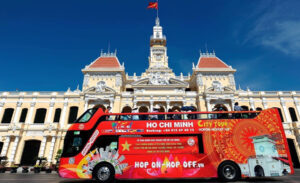 There is an open-top double-decker bus in the city center. The vehicle has an automatic multilingual commentary system to guide you to places on the road, tourist maps, free wifi, and tour guides. Each trip lasts about 60 minutes, passing famous places such as the Saigon Zoo, War Remnants Museum, Bui Vien Walking Street, Ben Thanh Market, Nguyen Hue Walking Street, City Theater and ending with an experience of viewing the city from above at Saigon Skydeck on the 49th floor of Bitexco Financial Tower.
There is an open-top double-decker bus in the city center. The vehicle has an automatic multilingual commentary system to guide you to places on the road, tourist maps, free wifi, and tour guides. Each trip lasts about 60 minutes, passing famous places such as the Saigon Zoo, War Remnants Museum, Bui Vien Walking Street, Ben Thanh Market, Nguyen Hue Walking Street, City Theater and ending with an experience of viewing the city from above at Saigon Skydeck on the 49th floor of Bitexco Financial Tower.
The bus operates from 9am to 10:30pm every day, with a trip every 30 minutes. In the evening, the bus offers an additional dinner service package on a luxury cruise along the Saigon River. Tickets can be purchased directly at the counter at the departure point 92-96 Nguyen Hue, Sai Gon ward or booked online.
Stroll in the park
 The Saigon Zoo has existed for more than 150 years, and is the 8th oldest zoo in the world. It was originally a botanical garden, serving the conservation of flora and fauna for city residents and a research site for scientists. Currently, the Zoo has more than 1,000 animals, more than 2,000 trees of 260 species, 23 species of domestic orchids, 33 species of cacti on an area of 17 hectares. The campus here is fresh, suitable for relaxing sessions.
The Saigon Zoo has existed for more than 150 years, and is the 8th oldest zoo in the world. It was originally a botanical garden, serving the conservation of flora and fauna for city residents and a research site for scientists. Currently, the Zoo has more than 1,000 animals, more than 2,000 trees of 260 species, 23 species of domestic orchids, 33 species of cacti on an area of 17 hectares. The campus here is fresh, suitable for relaxing sessions.
Covering 52ha on the conner of Lac Long Quan and Hoa Binh Street, Dam Sen Park is composed of various areas. There is an area for entertainment, including a central flower 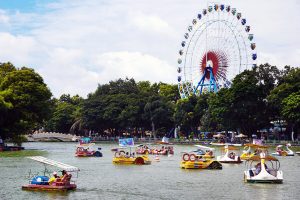 garden, water fountains, pine tree hills, a rose garden, a prehistoric valley, a fun house, a ball game centre, electronic game, and make-up rooms. There is also an area for camping, a lake offering many aquatic activities and a large scaled water park which is convenient not only for city dwellers, but also tourists to come and enjoy here.
garden, water fountains, pine tree hills, a rose garden, a prehistoric valley, a fun house, a ball game centre, electronic game, and make-up rooms. There is also an area for camping, a lake offering many aquatic activities and a large scaled water park which is convenient not only for city dwellers, but also tourists to come and enjoy here.
Or just outside the city center is 25ha of Suoi Tien includes a sightseeing area, and a high quality entertainment area. Visitors to Suoi Tien also have a chances to immerse themselves in the poetic land-scapes and see the Sea World with hundreds of species of fish which are breeding in the glass tanks.
Listen to live music
 Sipping a cup of coffee or a glass of wine and enjoying live music is one of the experiences in Ho Chi Minh City, especially in the evening. Live music performance spaces have long attracted a large number of locals and tourists. In the evening, each place has its own musical taste, from vibrant rock, to impromptu jazz, gentle acoustic or deep love songs.
Sipping a cup of coffee or a glass of wine and enjoying live music is one of the experiences in Ho Chi Minh City, especially in the evening. Live music performance spaces have long attracted a large number of locals and tourists. In the evening, each place has its own musical taste, from vibrant rock, to impromptu jazz, gentle acoustic or deep love songs.
Some suggested addresses: Ben Thanh tea room, We, Khong Ten, Dong Dao. Acoustic bars or cafes: Yoko Cafe, Rock Fan Club, Sax N’ Art Jazz Club, Acoustic Bar, Drinking & Healing, Sesame… Some of them the rooftop bar also offered same services with a panoramic view of Saigon.
Have fun on backpacker area
 Locals and tourists often call the Bui Vien – De Tham – Pham Ngu Lao area in Ben Thanh ward, the backpacker area, which operates from late afternoon until dawn the next day. The street includes free public facilities such as restrooms, wifi connections and tourist information stations.
Locals and tourists often call the Bui Vien – De Tham – Pham Ngu Lao area in Ben Thanh ward, the backpacker area, which operates from late afternoon until dawn the next day. The street includes free public facilities such as restrooms, wifi connections and tourist information stations.
Both sides of the street are lined up with bars, pubs and restaurants packed tightly, each offering fresh beer, delicious food, cafes, and loud music that always creating a lively atmosphere. Therefore, it attracts lots of travelers from around the world, suitable for young tourists, especially backpacker. All gather here for a busy, fun, and exciting nightlife.
Explore the life and cuisine of Chinatown
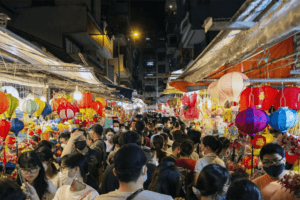 Chinatown includes wards but the most bustling and well-known is Cho Lon, An Dong and Cho Quan. Along the streets of Tran Hung Dao, Chau Van Liem, Luong Nhu Hoc… visitors will see rows of ancient houses with bold Chinese architecture that are about 100 years old. There are also many ancient pagodas, assembly halls, and typical Chinese restaurants. Dishes that cannot be missed include roast duck, braised offal, curry fish balls, pulled noodles, stewed chicken, dim sum…
Chinatown includes wards but the most bustling and well-known is Cho Lon, An Dong and Cho Quan. Along the streets of Tran Hung Dao, Chau Van Liem, Luong Nhu Hoc… visitors will see rows of ancient houses with bold Chinese architecture that are about 100 years old. There are also many ancient pagodas, assembly halls, and typical Chinese restaurants. Dishes that cannot be missed include roast duck, braised offal, curry fish balls, pulled noodles, stewed chicken, dim sum…
Luong Nhu Hoc lantern street is one of the attractive spots during the Mid-Autumn Festival, especially in the evening when colorful and stylish lanterns create a sparkling beauty for the street. Oriental medicine street is also a place that creates a unique image here. For a long time, Chinese merchants have transported medicinal herbs for trade and gradually formed a bustling medicinal herbs street as it is today.
Enjoy traditional show
Currently, there are 02 popular traditional show that held daily: water puppetry show and A O show.
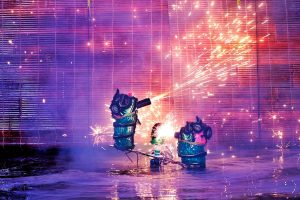 The water puppetry show is one of the most famous traditional shows in Vietnam. The show brings to you a great chance to learn more about Vietnamese culture, see puppets move underwater and on the surface of the water, listen to folk songs, and immerse yourself in the peaceful life of Vietnam in the past. The shows start at 17:00 and 18:30 daily and last about 30 minutes, you can buy a ticket at 55B Nguyen Thi Minh Khai Street, Ben Thanh Ward.
The water puppetry show is one of the most famous traditional shows in Vietnam. The show brings to you a great chance to learn more about Vietnamese culture, see puppets move underwater and on the surface of the water, listen to folk songs, and immerse yourself in the peaceful life of Vietnam in the past. The shows start at 17:00 and 18:30 daily and last about 30 minutes, you can buy a ticket at 55B Nguyen Thi Minh Khai Street, Ben Thanh Ward.
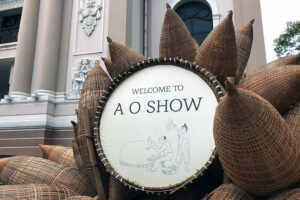 A O Show is a dazzling theatrical display that is a part bamboo circus, part dance spectacle, and a wholly thrilling treat for the senses. The A O Show is an ode to the charming beauty and cultural richness of Vietnamese country life, which stands in stark contrast to the city’s rapid urbanisation.
A O Show is a dazzling theatrical display that is a part bamboo circus, part dance spectacle, and a wholly thrilling treat for the senses. The A O Show is an ode to the charming beauty and cultural richness of Vietnamese country life, which stands in stark contrast to the city’s rapid urbanisation.
The show is set to “live” music inspired by traditional Southern Vietnamese folk songs; such songs evoke the memories of those who toiled on the lands and rivers in the Mekong Delta region. You can book a ticket and join a show at Operate House – 07 Cong Truong Lam Sơn, Sai Gon Ward.
Shopping in Ho Chi Minh
Shopping when traveling to Saigon you have a lot of different choices depending on your pocket and what you want to buy. If you have a lot of money, you can choose large commercial centres, combine eating and participating in many attractive entertainment activities. Another option is visiting the markets with reasonable prices but still selling all kinds of specialities. Below are some of the most popular destinations for “shopaholics”.
Ben Thanh Market
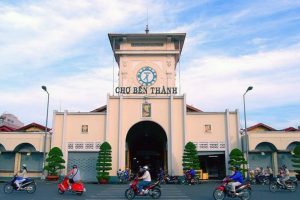
Ben Thanh is a famous market in Saigon and has a long history associated with the typical culture of local people. Ben Thanh Market has a total area of about 13,000m2, selling all kinds of items from shoes, clothes, cosmetics, handicrafts, fruits, fresh foods, and specialities as gifts…
Ben Thanh Market is considered a symbol of Saigon tourism, attracting a large number of tourists to visit and shop. Not only that, when coming to this famous market in Saigon, you can also take pictures as a souvenir at the market gate with the image of a clock like living virtual at Big Ben in England.
Location: Ben Thanh ward.
Binh Tay Market

The market is located in the Cholon area. It was built in the 20s of twentieth century, on an area of more than 17,000 m² in the style of ancient Asian-style architecture. Binh Tay Market currently has more than 2,300 stalls and business stalls with more than 30 groups of products. Every year, over 120,000 foreign tourists come to visit and shop at the market brought by travel companies across the country.
Coming to Binh Tay market, visitors can just admire the ancient architecture, learn the history of the market and shop at reasonable prices.
The main gate locates at 57 Thap Muoi, Binh Tay Ward.
Saigon Square
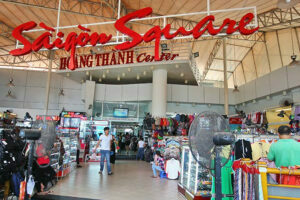
With a variety of items, and especially affordable prices, Saigon Square is known as the “Shopping Paradise in the heart of the city”… It’s hard to find a place in Saigon to buy yourself outfits that are both beautiful and unique but affordable when coming here.
Furthermore, products are constantly updated according to the latest fashion trends in many sizes, especially clothes, and shoes. Spacious, airy, air-conditioner works during opening time, the quality of goods here is relatively good, the customers are mainly local young people and foreigners who like to shop when travelling. And people often compare Saigon Square as a market but it is a high-class market.
Address: 77 – 89 Nam Ky Khoi Nghia Street, Sai Gon Ward.
Vincom Center
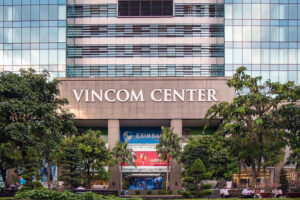
This is a large commercial centre in Saigon, where you can find many shopping, dining or office rentals. Vincom Center is divided into 2 buildings Vincom A (address 72 Le Thanh Ton) and Vincom B (address 45A Ly Tu Trong).
The building was designed in French architecture, where international products with big and prestigious brands are displayed. In addition, coming to Vincom, you will enjoy delicious and attractive dishes, dishes with the quintessence of countries prepared by skilled chefs.
SC VivoCity
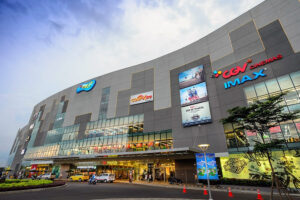 SC VivoCity inherits the success of Singapore’s largest shopping mall – VivoCity – which was voted as one of the “top 10 shopping destinations of the world” in 2011. SC VivoCity has located in the busiest South Saigon urban area in Ho Chi Minh City and is only about 5 km from the city centre.
SC VivoCity inherits the success of Singapore’s largest shopping mall – VivoCity – which was voted as one of the “top 10 shopping destinations of the world” in 2011. SC VivoCity has located in the busiest South Saigon urban area in Ho Chi Minh City and is only about 5 km from the city centre.
With a total booth area of 41,000 m², a scale of 5 floors and 1 basement, SC VivoCity Vietnam will be a space that integrates all shopping, dining, and entertainment facilities, ensuring the satisfaction of all needs of your family members.
Address: 1058 Nguyen Van Linh Street, Tan Hung Ward.
Saigon Center Shopping Center (Takashimaya)
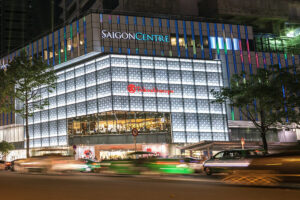
Shopping in Ho Chi Minh City cannot be missed Saigon Center Shopping Center also known as Takashimaya – is a luxury shopping paradise with all kinds of expensive services. Takashimaya’s location on Nam Ky Khoi Nghia Street is considered a “golden” location in Saigon, decorated with impressive architecture. This is the largest and most modern commercial centre in Saigon integrated between many different services.
The booths at Saigon Center Shopping Center are divided into separate zones and beautifully decorated for virtual living. In particular, it must be mentioned that Runam cafe is famous for delicious drinks, a beautiful space for super quality pictures to live virtual. Takashimaya is an ideal destination in Saigon for both shopping and check-in.
Address: 92 – 94 Nam Ky Khoi Nghia, Sai Gon Ward.
Cuisine of Sai Gon
When it comes to places with rich cuisine perhaps Saigon is the best. The city gathers almost of delicious dishes, sold in different forms, from big markets to small alleys. Now, you can find a bowl of “bun bo Hue” with the original taste without going to Hue, or a bowl of ramen noodles without having to fly to Japan. Here are the most popular places where you can get a great experience with local food.
Ho Thi Ky street food
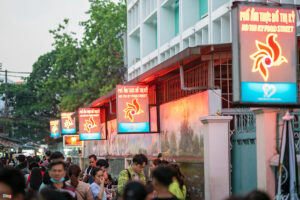
Not only famous as a flower market, Ho Thi Ky is also well known for its street food for a long time. This is the convergence of attractive dishes from many regions of Vietnam, Cambodia, and China…some of them from Korea and Japan as well. Although the market is only encapsulated in a section of less than 200m, there are countless shops, from appetizers, main meals, desserts, from soups to dried or, grilled skewers and processed seafood such as grilled lobster with cheese and grilled squid teeth with salt and chili. Dishes range in price from 7,000 to 100,000 VND ….all of them look so attractive but very cheap.
Food stalls at Ho Thi Ky market are usually open from 15:00 – 23:00, so you can arrange to have a “full” experience here.
Address: Alley of Ho Thi Ky Street, Vuon Lai Ward.
Vinh Khanh snail street
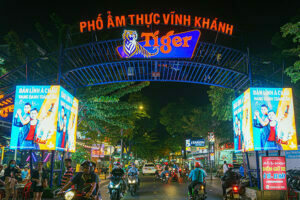
Snail dishes are a specialty of Ho Chi Minh City. Anywhere in the city, you can see snail shops. And if you’re a “fanatic” of snail dishes, Vinh Khanh would be the best area to come and experience. The buzzing street of local seafood and freshwater snails is located in Khanh Hoi Ward – close to Ben Thanh Ward. While other snail shops only open at night, these snail shops on this street start operating in the early afternoon until midnight, crowded with customers.
You might be surprised at the range of snail options available from these shops. Unlike Hanoi snails, which often have a typical cooking style of steaming lemongrass and dipping in chili fish sauce, snails in Ho Chi Minh City are prepared in a variety of ways, from salted egg sauce, to stir-frying tamarind, grilled with chili salt, and stir-fried with satay. Snail dishes cost from 80,000 to 150,000 VND per portion depending on the type of snail.
Address: Vinh Khanh Street, Khanh Hoi Ward.
Cholon – Saigon Grand Food Court
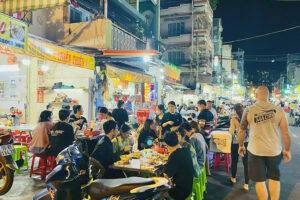
Cholon is one of the oldest marketplaces in the city. The area also known as China Town in Ho Chi Minh City, consists of several joining wards from Cho Lon, An Dong, Cho Quan, Binh Tay… but the busiest and most famous is Cho Lon area. The dishes are inclined towards Chinese dishes, and menus are presented in Chinese and Vietnamese. If you love Chinese cuisine, don’t forget to note this food court!
Not only have extremely diverse menus that attract the expat Chinese community but also the locals in Ho Chi Minh City. In addition, to visit and enjoy the cuisine, you can also witness a very vibrant Chinese life right in this city. Dishes not to be missed include roast duck, stew with organ meats, curry fish balls, pulled noodles, steamed chicken….
Turtle Lake area

Turtle Lake is the name of the fountain located right in the middle of the roundabout, Xuan Hoa Ward. The area is famous for snacks, at affordable prices such as rice paper, spring rolls, sweet cakes, and soft drinks.… mainly attracts young locals. Most of the vendors sell rice paper mixed with all kinds of processing such as mixing, rolling or baking… which is very strange.
Coming to this area, you also have a great chance to see the bustling Saigon streets with shimmering and brilliant street lights at night.
Location: The intersection of Vo Van Tan, Pham Ngoc Thach, Tran Cao Van streets, Xuan Hoa Ward.
Ha Ton Quyen Jiaozi Area
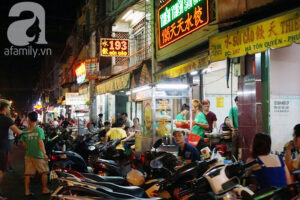
Located near the Cholon area, Ha Ton Quyen Street has been famous for selling the best jiaozi in Saigon for decades. In the early afternoon, this street becomes bustling, crowded with people coming to enjoy the famous bowls of delicious jiaozi. The menus have a variety of shrimp, vegetarian, mixed, and fried… served with bar broth and vegetables. Each line has its own highlight depending on the taste and choice of each person. The jiaozi here made with authentic Chinese recipes will help warm your stomach at night or satisfy the curiosity of first-time eaters.
Location: Ha Ton Quyen Market.
Besides this street food, there are still other famous areas that you should not miss such as Tan Dinh & Co Giang Market in Ben Thanh Ward, Alley 200 Xom Chieu in Xom Chieu and Khanh Hoi Ward…where you can easily find a good meal at a “surprise price”.
Vung Tau areas
 Vung Tau areas famous with seafood and Khot cake. Typical coastal seafood dishes you should enjoy include snails grilled with onion grease, blood cockles stir-fried with garlic butter, mantis shrimp dish, steamed grouper with ginger served with vermicelli, add a plate of garlic fried rice, fried squid with fish sauce. In addition, many tourists think that going to Vung Tau without eating stingray hotpot means they have not been here.
Vung Tau areas famous with seafood and Khot cake. Typical coastal seafood dishes you should enjoy include snails grilled with onion grease, blood cockles stir-fried with garlic butter, mantis shrimp dish, steamed grouper with ginger served with vermicelli, add a plate of garlic fried rice, fried squid with fish sauce. In addition, many tourists think that going to Vung Tau without eating stingray hotpot means they have not been here.
If you want to eat delicious stingray hotpot, you should go to Nguyen Truong To street, because this is a “stingray hotpot” street with many restaurants that have been open for more than 30 years.
Khot cake: The ingredients to make the cake are rice flour and shrimp to make the cake filling. In addition, some local shops also make pork, beef, squid, and scallops. Sprinkle a layer of shrimp powder on the surface of the cake. The cake is poured directly onto the cast iron oven and then brought out to guests so it stays crispy and hot. Shrimp tastes sweet when eaten. Khot cake is often eaten with sweet and sour fish sauce, fresh vegetables, mint, herbs.
Above is a combination of travel guides to explore Ho Chi Minh City. Vietdreamtravel is also running daily tours; package tours; car/bus rental services and Vietnam visa services to explore this lovely destination. Don’t hesitate to contact us at (+84)28 3838 8322 +(84)918 709 338 for more details.
Source: collected by An
